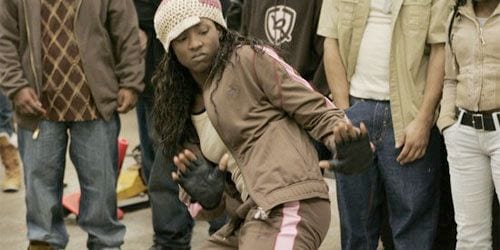
Raya (Rutina Wesley) wants out of the ghetto. More specifically, she’s planning on med school (Johns Hopkins, because she knows how good she is), in order to leave behind Toronto’s tough Jane-Finch corridor. But even as she’s making As in prep school, she finds herself called home when her sister dies of a drug overdose.
All this plot unfolds in the first two minutes of How She Move. As Raya ponders her future, suddenly so different from what she thought, she’s caught up in a swirl of emotions. Grieving and frustrated, she’s also used to being the “good girl” and determined to help her financially strapped West Indian parents, Faye (Melanie Nicholls-King) and David (Conrad Coates). To that end, she puts up her usual solid front: “I have everything under control,” she asserts more than once. Because Faye’s distracted, she doesn’t notice that, in fact, Raya is in all kinds of trouble of her own, not least being the tensions she’s feeling back at public school, where her sister’s friends, feeling their own unarticulated guilt, as well as resentment at Raya for leaving, taunt and abuse her. When a math teacher pushes Raya to show off what she’s learned at the fancy school, her classmate Michelle (Tre Armstrong) ends up humiliated and infuriated. Payback is sure to come.
Michelle knew Raya’s sister, and still hangs out with the same troubled and troublemaking crowd, drinking and smoking dope (Raya advises Michelle to quit with this bumper-sticker line: “You start making people like this a habit, then you’re the habit”). Michelle holds herself together in hr own way, leading a competitive dance crew, Fem Phatal. This plot point opens up the movie to its primary metaphor: dance as life. Per formula, How She Move here provides a romantic rivalry, as Michelle feels possessive of another dancer named Bishop (Dwain Murphy), who is in turn interested in Raya. Tensions mount, Michelle and Raya come to actual blows, and their principal decides to solve the problem by assigning Raya to peer tutor Michelle, who is (predictably) failing out of school.
Even as this arrangement sets up for some serious girl bonding, Raya is briefly detoured by her desire to get back into prep school. Resisting the routines that she feels subsumed her sister (“That’s all this place is,” she tells Bishop, “A whole lot of people killing themselves over things that don’t even matter”), Raya focuses on escape. After a scholarship exam goes badly, she determines that her only ticket is dance contest prize money. Come to find that Raya — like her sister before her — is a fierce and creative dancer. And because everyone knows the girls’ teams can’t make the same kind of money as the boys (dance as life, again), she has a hard time convincing Bishop to let her onto his crew, as mixed gender teams are regarded as gimmicky and unserious, and don’t win contests. Not to mention, his longtime boys — including E.C. (Kevin Duhaney) and Trey (Shawn Desman) — aren’t keen on a girl teammate, especially when, as Raya does during her audition, she out-moves them. Still, they take a chance, such that Raya overcomes yet another of the numerous hurdles that constitute her plot.
This plot, as much as it embraces melodramatic clichés and the sort of “let’s put on a show” steps familiar in musicals from Fred Astaire to Andy Hardy, is buoyed by How She Move‘s energetic dance numbers (choreographed by Hi Hat) and its focus on Raya’s enduring academic ambitions (true, she doesn’t spend much time studying once the dance rehearsals begin, but the idea is ever hovering). It helps that, unlike the better financed, U.S.-made hiphop dance movies (You Got Served, Stomp the Yard, and even, in its awkward way, Honey), How She Move stars some serious dancers. Some of the most compelling aspects of Raya’s emotional journey are rendered through dance, especially when she discovers some sensational moves designed by Bishop’s underappreciated younger brother Quake (Brennan Gademans). (His stereotyping is another issue, as he wears glasses and argyle sweaters, sure signs of why his brother rejects him out of hand, as well as his nerdish comprehension of aesthetics and physics.)
All the teams — including Fem Phatal and Bishop’s crew, JSJ — seek entrance to the national finals in Detroit, Step Monster (emceed by Keyshia Cole and DeRay Davis, playing strikingly uncharismatic versions of themselves). Here the various plot strands come to heads, including Raya’s coming to terms with her sister’s bad choices and death, and her own deceptions.
Lying to Faye and David about what she’s doing (her mother disapproves of dancing most vehemently, as she associates it with her older daughter’s drug use), Raya keeps telling herself she’s doing it to get out, to be the success her mother needs her to be (Raya’s own needs reflect Faye’s). The few scenes that showcase Raya’s relationship with her mother reveal tensions that are at once delicate and deep. Such complexity is offered mostly in Wesley and Nicholls-King’s work together, as they overcome a script that has Faye warning, “Young people always think they can have everything, but life has a way of teaching you different!” Right. Except when you’re in a dance contest movie, in which case, life does no such thing.

![Call for Papers: All Things Reconsidered [MUSIC] May-August 2024](https://www.popmatters.com/wp-content/uploads/2024/04/all-things-reconsidered-call-music-may-2024-720x380.jpg)



